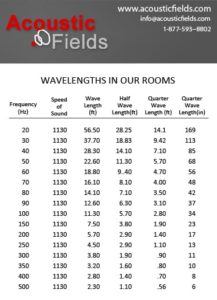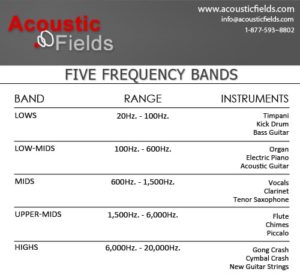Waves and rays sounds like something out of a science fiction movie. It conjures up images of Star Wars episode with lasers and energy waves blasting into space or at each others space ship. Nothing fictional about these two terms. Waves are lower frequency sound energy and rays are the term used for higher frequency sound energy. Waves are energy below 3oo Hz., rays anything above. Both terms are used when referring to sound energy within our listening, home theater, or professional recording environments. Waves of energy are felt through our bones, not heard with our ears, like rays.
Waves And Rays – Hearing Range
Human hearing has a small range of frequencies to it when compared with other animals. With this limited range of hearing, it is fortunate that our brains have evolved to interpret this data in the many ways that it does. The lower limit of human hearing is usually represented by 20 Hz. A 20 Hz. wavelength is calculated by dividing the speed of sound which is 1,130 ft. / sec. by the wavelength 20. Using this quotient, we find that a 20 cycle wave is around 56′ long. The upper end of the human hearing range is usually represented by 20,000 Hz. Dividing 1,130 by 20,000 produces a wavelength at 20,000 Hz. of .06 of an inch. We have 56′ on the low end up to .06″ on the high end. We need to break this down into two groups to examine their impact on creating a resonant cavity within our room.
Waves Vs. Rays
How do we break down this wide range of wavelengths into categories that we can use to our acoustical benefit. We let the dimensions of our room tell us what the wavelength breakpoints will be. Rays of sound energy obey the law of physics that states angle of incident equals angle of reflection. Lets take a 200 Hz. wavelength. We know how to calculate its length. We take 1,130 and divide by 200. This gives us about 5.5′ in length. This wavelength of 200 Hz. will strike the walls or ceiling in our room and whatever angle it strikes at on that surface it will rebound or reflect from that angle of incident at the same angle.
Room Dimensions
Most of our rooms are wider or longer than 5′, so we have many reflections going on from wavelengths that fit into our rooms. Even a wavelength of 100 Hz., which is 11′ long, can fit between two walls and obey the law of angle of incident equals angle of reflection. However, lets take a wavelength of 60 Hz. which is 1,130 / 60 or 19′. With a 19′ length, we have a different situation. If our room is 12′ wide, our 19′ wave will not correspond to angle of incident equals angle of reflection. This is where we apply wave theory and not ray.
Too Long For Room
When wavelengths do not “fit” into the dimensions of our rooms, they can cause many issues. Think of lower frequencies as sumo wrestlers in your studio apartment. They are large and long waves that do not have the space to move around freely. Since they are too large for the room, they are always trying to leave the room by going through walls or finding openings to escape through. Most stay in the room and vibrate which is their way of showing discontent. It is similar to a woman who is a size 16 dress, wearing a size 8. All parts are trying to escape the confines of the dress. Men at the gym wear tight shirts to show off their muscles. One could say their muscles are trying to escape the confines of the shirt.
Resonances
Waves create resonances within our rooms because the room dimensions are smaller than their associated wavelengths. This inability to “breath” or travel freely to one’s full length is like a 7′ tall man in a Volkswagen Bug, it will not be happy. It will excite certain resonances within the room. The frequency of these resonances is determined by the dimensions of the room and the length of each frequency within the room. Resonances are not wanted acoustically and can blur and smear other shorter frequencies to the level that we may not hear the shorter frequencies or they may be too pronounced. Either way, it is something we do not want, as we try to acoustically balance our rooms.
Region A
To make this division between waves and rays easier to understand, we divide our room’s frequency response into four main regions. Lets call them regions A,B,C, and D. Region A is all wavelengths that meet the criteria of 1130 / 2L where L is the longest dimension of the room. These frequencies are not boosted by any other frequencies because there are none that are lower. Region A is the lowest of all the frequencies that will fit into your room based on its dimensions.
Region B
Region B is the region where the dimensions of the room are compatible with the wavelength of sound we are looking at. The lower frequency boundary for this region is 565/L. The upper limit to region B is not an exact frequency but includes calculations using reverberation times and room volume to calculate. The upper limit of region B is where we have the cutoff or room crossover frequency occurring.
Region C
Region C is termed the transition region since probably they could not figure out what to call it. We are still in the wave acoustics area to predict behavior of these frequencies. However, both waves and rays are present in this third region. It is a difficult region dominated by wavelengths often too long for ray acoustics and too short for wave acoustics.
Region D
Region D is all about higher frequencies that do correspond to angle of incident equals angle of reflection or specular reflections. This is the region where we can use geometric acoustics. We can use ray acoustics in this area to predict behavior of these specular reflections. This is the area where sound diffusion and sound absorption technologies usually refer to when they talk about how effective their technologies are.
Waves And Rays
Waves and rays are different creatures. Waves are felt through bone conductance and rays are received through our ears. Waves are like the waves on a beach and rays are the white water after they strike the beach. Waves cause “bass boom” in our rooms and rays are responsible for reflections that can confuse our wanted direct energy from our speakers. Both waves and rays are responsible for room sound. Both must be managed through proper room acoustic technologies and proper room size.








2 Comments